Dieting and Weight Loss
Fly Swatter Vogue

Boston Globe - Mar 24, 1927
via Useless Information
Posted By: Alex - Tue Jul 12, 2022 -
Comments (1)
Category: Beauty, Ugliness and Other Aesthetic Issues, 1920s, Dieting and Weight Loss
Lucky Strikes as Weight-Loss Aid
See more in this series at the link.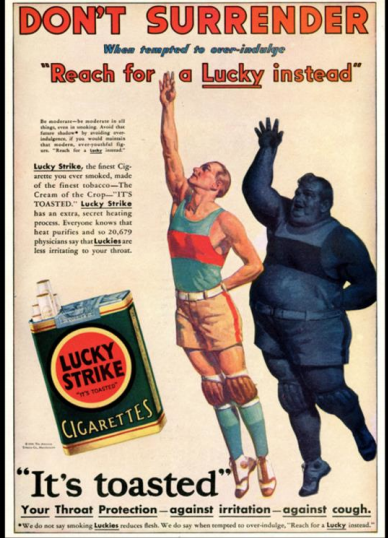
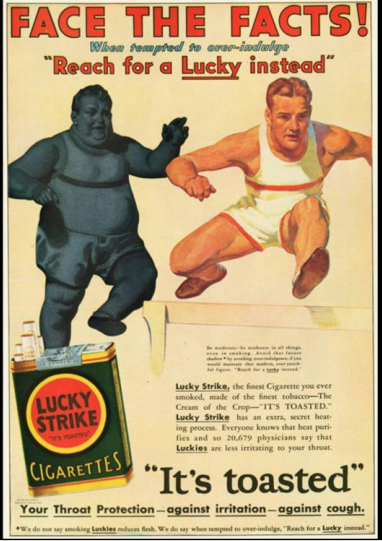
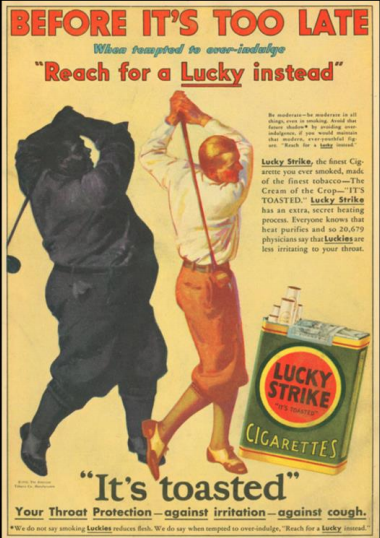
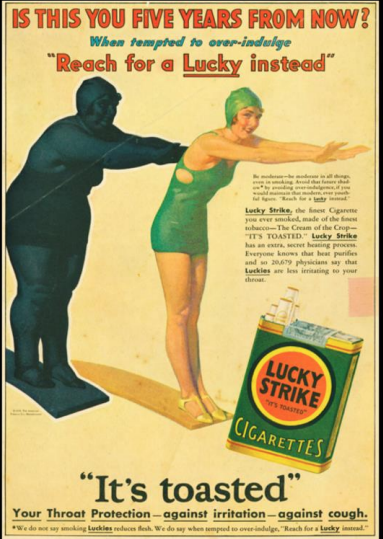
Posted By: Paul - Mon Jul 26, 2021 -
Comments (1)
Category: Advertising, Smoking and Tobacco, Twentieth Century, Dieting and Weight Loss
The DentalSlim Diet Control
Researchers have unveiled a new weight-loss device that involves attaching magnetic bolts to a person's jaw so that they can't open their mouth more than 2mm wide. This allows them to consume liquid foods, but no solid ones.
People who have used the device said that it did help them lose weight, although it made their lives, in general, "less satisfying".
The researchers emphasized that the device isn't intended for your average dieter, but rather for people struggling to lose weight so that they can have weight-loss surgery.
It reminds me of the anti-eating face mask patented in 1982.
More info: British Dental Journal, University of Otago, Fox News
Posted By: Alex - Thu Jul 01, 2021 -
Comments (2)
Category: Dieting and Weight Loss
The Shipwreck Diet
Studies conducted by the U.S. Army in the late 1940s sought to determine the minimum amount of food a person would need to survive if they were shipwrecked on a desert island.One of the oddities the researchers discovered was that if, for some reason, the shipwrecked person had to choose between steak and water, they should choose the water: "Protein has the effect of drying up the body. Therefore eating a steak on a desert island with little or no water available would probably be worse than eating nothing, depending upon how long rescue took."

"Shipwreck Diet: One of eleven Army volunteers who for six weeks will live on biscuits and water at the Metropolitan Hospital, New York City, to determine a human survival ration."
Newsweek - Mar 15, 1948


Waterloo Courier - Nov 16, 1949
Posted By: Alex - Mon Nov 16, 2020 -
Comments (4)
Category: Food, Nutrition, Experiments, 1940s, Dieting and Weight Loss
Trim Reducing-Aid Cigarettes
The Cornell Drug Corporation came out with Trim Cigarettes in 1958, claiming that smoking three of them a day would reduce appetite and thereby help with weight loss:The FDA promptly banned them. More info: wikipedia


Miami News - May 16, 1958
Posted By: Alex - Sat Nov 14, 2020 -
Comments (0)
Category: Smoking and Tobacco, 1950s, Dieting and Weight Loss
Roy Mack’s milk-diet tour
Roy Mack set off from New York on May 2, 1939, intending to walk to San Francisco. To make this more of a challenge, he decided to do this while living on a diet of only milk — about six quarts of it a day. He said he wanted to "prove you can live on milk." The media dubbed him the "human milk bottle."By August he had reached Oklahoma City and had also lost 10 pounds in weight. He maintained this was due to all the exercise, not his milk diet.
I have no idea if he ever did reach San Francisco, because I can't find any news reports about him after Oklahoma City. Perhaps the milk diet got the better of him.

Pittsburgh Press - June 3, 1939
Posted By: Alex - Fri Oct 30, 2020 -
Comments (0)
Category: Food, Publicity Stunts, Travel, 1930s, Dieting and Weight Loss
Bitten desserts in advertisements
Do consumers find images of desserts in advertisements more appealing if the desserts are whole, cut, or bitten?The answer: it depends on whether or not the consumer is currently on a diet. That's according to research conducted by Donya Shabgard at the University of Manitoba for her 2017 master's thesis. From the thesis:
These findings explain that the bitten dessert is percieved as more real and authentic in comparison to the cut and whole dessert, and, thus, these perceptions of realness resulted in its positive evaluations. After the bitten dessert, the cut dessert was perceived as being the next most real, with the whole dessert being viewed as the least real of the three.


via Really Magazine
Posted By: Alex - Tue Jun 02, 2020 -
Comments (0)
Category: Food, Advertising, Psychology, Dieting and Weight Loss
Howard Obesity Ointment
I can't find any description of what was in this ointment, but it sounds like something out of a horror story.

Munsey's Magazine - vol 29, 1903
Posted By: Alex - Tue May 05, 2020 -
Comments (4)
Category: Health, Advertising, 1900s, Dieting and Weight Loss
The Tummy Tutor
It also went by the name "Belly Beeper". The idea was that if you slouched or let your stomach out, it would start beeping. Supposedly this would train you to always keep your stomach muscles tensed and not slouch.Either that or it would train you to avoid wearing it.
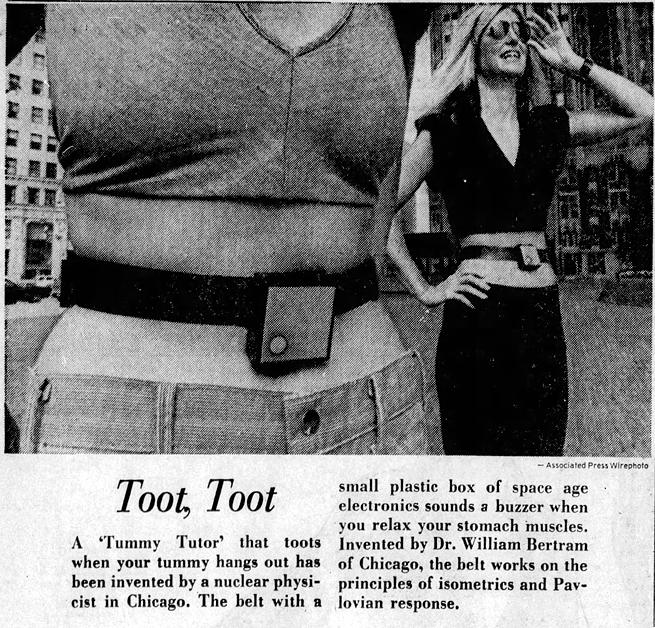
The Miami Herald - Oct 7, 1973
Posted By: Alex - Tue Apr 21, 2020 -
Comments (2)
Category: Inventions, 1970s, Dieting and Weight Loss, Stomach
Happy Humphrey, Heaviest Pro Wrestler of All Time
His Wikipedia page.
Posted By: Paul - Sat Jan 18, 2020 -
Comments (0)
Category: Body, Dieting and Weight Loss, Differently Abled, Handicapped, Challenged, and Otherwise Atypical, Enlargements, Miniatures, and Other Matters of Scale, Excess, Overkill, Hyperbole and Too Much Is Not Enough, World Records, Wrestling, Twentieth Century

| Who We Are |
|---|
| Alex Boese Alex is the creator and curator of the Museum of Hoaxes. He's also the author of various weird, non-fiction, science-themed books such as Elephants on Acid and Psychedelic Apes. Paul Di Filippo Paul has been paid to put weird ideas into fictional form for over thirty years, in his career as a noted science fiction writer. He has recently begun blogging on many curious topics with three fellow writers at The Inferior 4+1. Contact Us |




